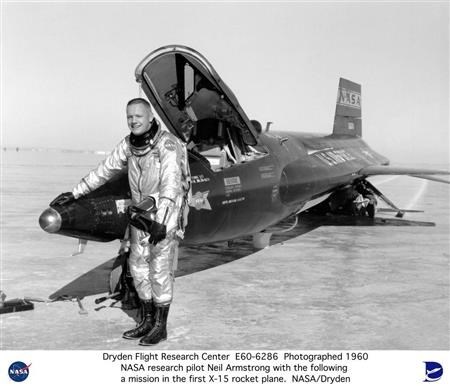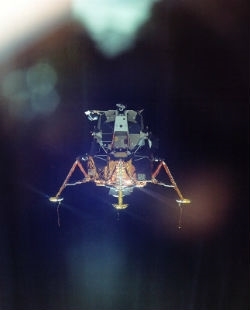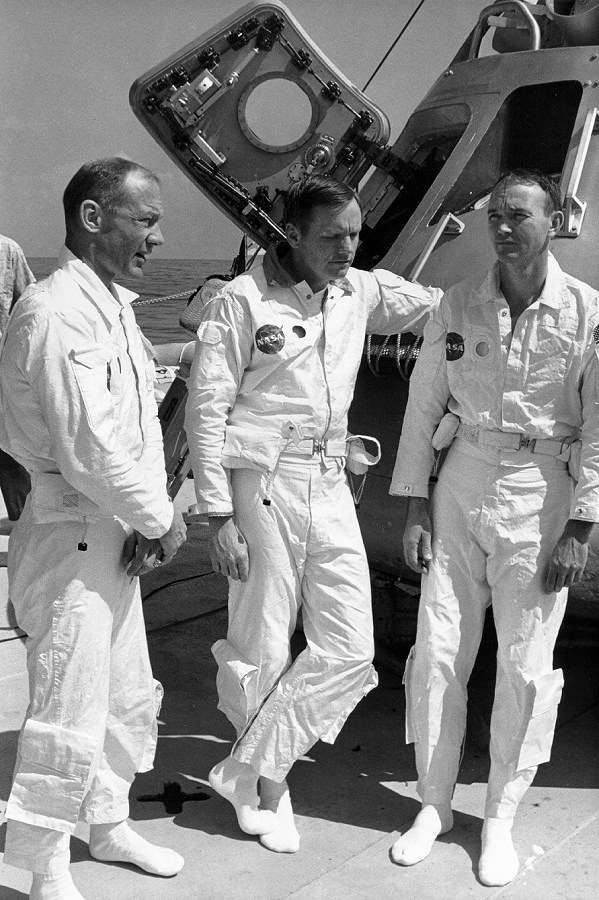 |
Fighter Jockeys, especially test pilots, have a stereotype of being very arrogant; however, Neil Armstrong was not, and was actually uncomfortable with all the attention he received from his part in the Apollo Program, which is a good trait of a hero. Neil Armstrong is a hero because he exhibits other traits like courage, Intelligence, and patriotism, and has been involved in groundbreaking and daring space exploration. He saw combat as a naval aviator in the Korean War, was a member of the Gemini Program and helped develop the procedures needed for the Apollo moon-shot, and was the first man to set foot on the moon when he was part of the Apollo 11 mission.
Armstrong's fascination with flight started when he was six years old, when he first went on an airplane flight. From there, his desire for flight only grew, and when he was 16 he got his student pilot license. Armstrong served as an officer in the Navy during the Korean War, and flew 78 combat missions, receiving three medals for his duty served. During one of his missions, he was struck by anti-aircraft fire from the North Koreans, lost a wing, and had to eject.
After his time in the Navy, he went back to college at Purdue University, graduated with a degree in Aerospace Engineering, and then promptly applied to be a test pilot at the Edwards Airforce Base High Speed Flight Station. This, and his Navy service, shows that he was patriotic to the United States, and especially courageous when one considers the dangers of test flying and space travel.
 |
| Apollo 11 Lunar Lander (NASA.gov (NASA)) |
Though the United States has been doing operations in outer space for many decades now, it is still dangerous, and was significantly more so during the early days during which Armstrong flew. When people think of spacecraft, they might think of designs like either the space shuttle, or something like the Apollo Moon capsules. The earliest designs for American spacecraft were neither.
 |
| Apollo 11 crew (NASA.gov (NASA)) |
Armstrong was one of the test pilots, and flew a total of 7 times. It's worth noting as evidence for his courage and patriotism that the X15 flights were very dangerous and killed one of the other test pilots.
Armstrong was also part of the Gemini Program, the second generation of orbital American space craft, where he and other astronauts would test equipment and procedures needed for the follow on Apollo moon missions. What would happen during the Gemini 8 mission would prove that Armstrong was not only brave, but intelligent and quick thinking.
The way the moon mission was laid out meant it would be necessary for two space craft to achieve the same orbit, and then connect together, a procedure called docking. NASA had never done something like this, and they weren't keen to try it for the first time with Apollo equipment, so they used Gemini.
Gemini was a two-man capsule; Armstrong would be commander of the mission, and his co-pilot would be David R. Scott. The plan was for them to launch and then dock with the unmanned satellite that was preplaced in orbit.
Things didn't exactly go according to plan.
They did successfully dock with the satellite, the Agena target vehicle, but almost immediately after they experienced near catastrophic issues.
Once they'd docked with the Agena, there was of course much excitement at ground control. However, the Gemini-Agena would soon be moving out of range of ground control until they return to the other side of the planet, so control sent them one last piece of advice in case they ran into an trouble: "If you run into trouble and the attitude control system in the Agena goes wild, just . . . turn it off and take control with the spacecraft."
The Agena-Gemini craft began to enter a spin. Something was wrong with the reaction control system, the series of small thrusters used to orient a craft and maneuver it in small distances. Of course, they immediately suspected the Agena as the problem, but they couldn't be sure. Either way, the Agena wasn't responding, and when they tried to use their thrusters to fight the spin it didn't really fix the problem. They would have to undock.
This did not fix the problem.
After they undocked, the Gemini 8 went into an even deeper spin. Despite being in peak physical shape, they nearly blacked out from the ever increasing g-forces. Armstrong and Scott realized that the problem must have been in the Gemini's RCS thrusters, and frantically tried everything to reset whatever switch had been stuck in the ON position. During all of this, Armstrong was also using the backup thrusters intended for bringing the ship back down safely to earth.
Keep in mind that the Gemini 8 was outside of communications range when this happened, so they had no help during this near catastrophe. If they ran out of fuel for the re-entry thrusters, they wouldn't have been able to safely re-enter Earth's atmosphere. Given that there's no friction in space, the Gemini would remain in orbit long after the men had asphyxiated or starved to death. They also could have had issues with getting back into Earth's orbit of a different kind, and burned up in the atmosphere, or come in at too steep of an angle, and then burn up in the atmosphere after breaking their necks due to G-force.
Despite all of this, they tried repeatedly to convince ground control to let them carry out the remaining objectives of their mission. Naturally, ground control objected to this and ordered them to carry out an emergency landing.
Of course, there's also what he's most famous for. As everyone knows, Neil Armstrong was the first man on the Moon. As another part of the disturbingly recurring theme of Armstrong and faulty spacecraft, the Lunar Lander's navigation system failed and he had to take it off course by several miles, then land it by hand, nearly running out of fuel in the process. Another trait that I think makes Armstrong heroic was the fact that he felt uncomfortable being in the spotlight, especially as he got older. Naturally, the first man on the moon is going to be a rockstar in the eyes of the world, but he felt that everyone else was being ignored.
The actions taken by Armstrong show his heroic traits of intelligence, needed to figure out and resolve the problems that emerged during his missions, extreme bravery needed to work under the absurdly hazardous conditions he was in, and patriotism to repeatedly put himself in danger to help the United States achieve its goal.
https://www.nasa.gov/centers/glenn/about/bios/neilabio.html
http://www.history.com/topics/neil-armstrong
http://www.cnn.com/2012/08/25/us/neil-armstrong-obit/
http://www.astronautix.com/flights/gemini8.htm
http://www.astronautix.com/flights/apollo11.htm
http://www.nasa.gov/audience/forstudents/5-8/features/nasa-knows/who-was-neil-armstrong-58.html
http://www.airspacemag.com/daily-planet/neil-armstrongs-x-15-flight-over-pasadena-59458462/?no-ist
http://www.purdue.edu/armstrong/
Page created on 1/10/2016 12:00:00 AM
Last edited 1/10/2016 12:00:00 AM
